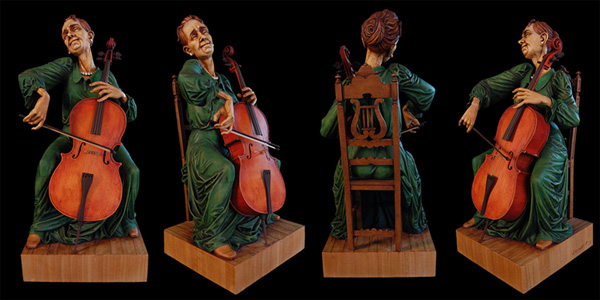Cellist was carved in 2007 and it is one of the very few woodcarvings I documented through the whole process. I decided to make this posts because it answers majority of questions I get from fellow carvers.
 Carving the cellist, caricature wood carving
Carving the cellist, caricature wood carving
According to a definition, “Caricature can refer to a portrait that exaggerates or distorts the essence of a person or thing to create an easily identifiable visual likeness…” (Vikipedia). Instead of trying to exaggerate the most obvious – cello, or the cellist’s proportions or position, I decided to exaggerate the essence of a cello player – hands (long fingers) and face showing complete obsession with music, the way she got lost in it…. I did not want a young girl, I wanted a mature, strong and independent woman – sensual, loving music and becoming part of the music she was playing….
Before I start any of my carvings I do a lot of research about the subject. The Cellist was not an exception. I had an idea of what I wanted but had to go through many pictures and watched several movies, documentaries, and concerts to observe cello players in action. Also had to find out a lot about cellos. When I finally knew exactly what I wanted to carve, I made a sketch and then I created a full scale clay model.
I am using Firm Kleen Klay (you can get soft, medium, firm and hard) – non toxic modeling clay. It is oil based – does not dry and you can re-use it for other projects. I usually put it in plastic bag when I am not using it, also, cover my clay models with plastic bags when I am not carving, this way it does not collect dust and dirt particles which would stick to it if left in open air for longer period of time.
To create the model I used 1/4 plumbing copper pipe (ideal for this model size – 16″, not too good for large models) – cheap and available; it is screwed to a piece of plywood (which is screwed to another wooden board). The frame moves a bit when when I apply too much pressure but it holds the form well. Sculpting tools I am using can be found in most art/craft supply stores and they are not expensive.
I made the cello at the same time as I was creating the clay model. Why? Because I needed to figure out the cellist’s exact position and the way she would hold and play her cello. Easy to do with clay. If I carved without model, I would be only guessing – and as you know, it does not always work.
Material used for this particular woodcarving – Basswood. One of the most asked questions – is the Cellist (and my other carvings) carved from one piece of wood? With the exception of few small pieces I laminate wood for all my carvings. So, the answer is yes, but it is not from one chunk of wood, it is few pieces of wood laminated together to form needed size….. Also, depending on a carving, some parts are carved separately (like the cello or chair in this case). I have to admit that I spend a lot of money on wood and always try to get the best I can get my hands on because I invest a lot of time in my carvings and it would be foolish to use anything else but the best.
In the next few pictures you can see the beginning of carving process and shaping the cellist’s form.
The Cellist is slowly taking the correct proportions and I started working on details – really, mostly on the fabric. I like playing with folds and wrinkles on all of my carvings – and this long dress just calls for it!
The carving is done, now is time for all the little details. The chair was made and carved separately from Maple wood. Also the hands had to be carved separately because of the grain and then they were glued in.
I really do not like painting my carvings but sometimes there is a need to add a bit of color. When I was looking at pictures of cellists on the internet and in magazines, I came across a picture of Canadian cellist Ofra Harnoy in a green velvet dress and since that moment I would see my cello player in green. BUT, I have to say that even when I use paints on my carvings, I am very careful and make sure that the wood can be seen through the paint. I use oil paints (used by artist to paint pictures). I really like them because they take some time to dry and that gives me more time to work with them (unlike acrylic paints which dry really fast and most of the time totally cover the wood making it look like plastic). I also make my stains (from oil paints) – I will write more about this in one of the next posts since it is something I get a lot of questions about.
Please visit Caricature Carving to see more of my caricatures or use menu on top of this page to navigate to other pages.
© Copyright Fred Zavadil, 2005-2023. Text, art work, and images on this website are protected by copyright. Any reproduction, retransmission, e-mailing or resale of images or website content is STRICTLY PROHIBITED without owner’s prior written consent.










































Absolutely stunning work .